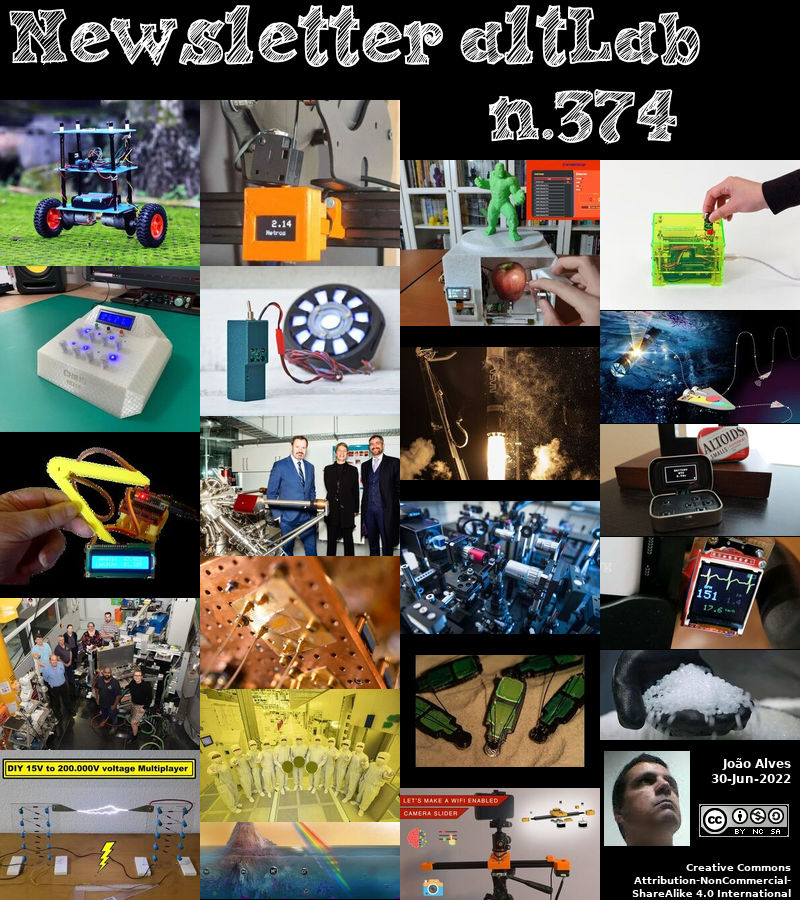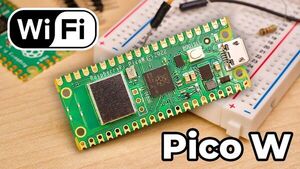2022-06-30 - Nº 374
Editorial
Esta é a Newsletter Nº 374 que se apresenta com o mesmo formato que as anteriores. Se gostar da Newsletter partilhe-a!
Todas as Newsletters encontram-se indexadas no link.
Esta Newsletter tem os seguintes tópicos:
Faz hoje anos que nascia, em 1791, o físico francês Félix Savart. Ele pesquisou várias manifestações de vibração. Com Jean-Baptiste Biot, ele desenvolveu a Lei Biot-Savart (1820) relativa à intensidade do campo magnético em torno de um fio condutor de corrente. Após ter obtido uma licenciatura em medicina (1816), interessou-se pela física, começando pelo estudo do violino para explicar as contribuições dos seus componentes para o som das cordas. Apresentou uma memória sobre o tema à Academia das Ciências de Paris em 1819. Conduziu uma extensa pesquisa sobre a acústica, os padrões nodais dos sistemas vibratórios (incluindo as colunas de ar), e inquéritos relacionados sobre a elasticidade das substâncias. Investigou também a voz e a audição. Concebeu uma roda dentada rotativa para produzir um som de qualquer frequência através de uma palheta segurada contra ela, para medir os limites da audição de alta frequência.
Faz também hoje anos que nascia, em 1795, o químico francês Joseph Bienaimé Caventou. Ele destacou-se pela investigação que fez em parceria com Pierre-Joseph Pelletier sobre bases vegetais e as contribuições resultantes da química alcalóide para o campo da medicina. Eles ajudaram a fundar a química dos alcalóides vegetais. Isolaram a clorofila (1817), para a qual cunharam o nome francês clorofila em Ann. de Chimie(1818), IX, 195. As suas descobertas alcalóides incluíam estricnina (1818), brucina (1819), quinina (1820), cafeína (1821), e cinchonina. Em 1823, utilizando análises elementares em tubos fechados em que os alcalóides eram queimados, descobriram a presença de azoto nos compostos. Os alcalóides são compostos orgânicos que formam sais solúveis em água que desempenham várias funções na medicina, incluindo analgésicos (analgésicos analgésicos), e estimulantes respiratórios.
Por fim, faz hoje anos que nascia, em 1926, o bioquímico norte-americano Paul Berg. Ele fez "estudos fundamentais da bioquímica dos ácidos nucleicos, com particular atenção às técnicas de recombinação do ADN", para as quais partilhou o Prémio Nobel da Química em 1980 (com Walter Gilbert e Frederick Sanger). A experiência pioneira de Berg, na qual ele foi a primeira pessoa a construir uma molécula de recombinant-DNA, iniciou a engenharia genética. Tais moléculas contêm partes de ADN de diferentes espécies, por exemplo, um cromossoma de um vírus combinado com genes de um cromossoma bacteriano. As moléculas de ADN de vírus, sendo relativamente pequenas, são úteis para tais investigações. As aplicações práticas importantes incluem agora o fabrico de hormona humana com a ajuda de bactérias.
Em 1894, a Tower Bridge sobre o Rio Tâmisa em Londres foi oficialmente aberta pelo Príncipe de Gales. A ponte tem 240 m de comprimento e consiste em duas torres de ponte de 65 m ligadas no nível superior por duas passarelas horizontais, e um par central de básculas que podem abrir para permitir a navegação. Originalmente alimentado hidraulicamente, o mecanismo operacional foi convertido para um sistema electro-hidráulico em 1972.
Em 1908, por volta das 7:15 da manhã, a noroeste do Lago Baikal, Rússia, uma enorme bola de fogo quase tão brilhante como o Sol foi vista a atravessar o céu. Minutos mais tarde, houve um enorme clarão e uma onda de choque sentida até 650 km de distância. Sobre Tunguska, um meteorito com mais de 50 m de diâmetro, viajando a mais de 25 km por segundo penetrou na atmosfera terrestre, aquecida a cerca de 10.000 ºC e detonou 6 a 10 km acima do solo. A explosão libertou a energia de 10-50 Megatons de TNT, destruindo 2.200 km quadrados de floresta, não deixando qualquer vestígio de vida. A rocha Tunguska saiu da tempestade de meteoros Taurid Meteor que atravessa a órbita da Terra duas vezes por ano. A primeira expedição científica cujos registos sobrevivem foi feita pelo mineralogista russo Leonid Kulik em 1927.
Há 50 anos, em 1972, foi necessário acrescentar o primeiro segundo (leap-second) ao tempo do mundo, a fim de manter os relógios atómicos super-acurados a par da rotação da Terra. Desde a adopção deste sistema em 1972, em primeiro lugar devido à escolha inicial do valor do segundo (1/86400 dia solar médio do ano 1900) e, em segundo lugar, devido ao abrandamento geral da rotação da Terra. Até 2015, foi necessário acrescentar 26 segundos ao Tempo Universal Coordenado (UTC)
E hoje foram lançados três novos membros da família Pico. O Raspberry Pi Pico W tem um preço de 6 dólares, e traz à plataforma Pico rede sem fios 802.11n, mantendo ao mesmo tempo a compatibilidade total de pinos com o seu irmão mais velho. O Pico H ($5) e o Pico WH ($7) acrescentam cabeçalhos pré-populados, e o novo conector de 3 pinos de debug, ao Pico e ao Pico W respectivamente. O Pico H e o Pico W estão disponíveis hoje; o Pico WH estará disponível em Agosto.
Na Newsletter desta semana apresentamos diversas noticias, artigos científicos, projetos de maker e alguns vídeos interessantes. É apresentada a revista MagPI nº119 de Julho.
 João Alves ([email protected])
João Alves ([email protected])
O conteúdo da Newsletter encontra-se sob a licença  Creative Commons Attribution-NonCommercial-ShareAlike 4.0 International License.
Creative Commons Attribution-NonCommercial-ShareAlike 4.0 International License.
Novidades da Semana
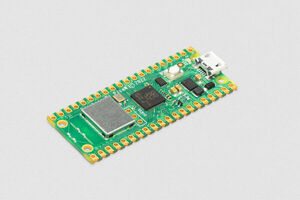
Raspberry Pi Pico W: your $6 IoT platform
"New product alert! In January last year, we launched the $4 Raspberry Pi Pico, our first product built on silicon designed here at Raspberry Pi. At its heart is the RP2040 microcontroller, built on TSMC’s 40nm low-power process, and incorporating two 133MHz Arm Cortex-M0+ cores, 264kB of on-chip SRAM, and our unique programmable I/O subsystem. Since launch, we’ve sold nearly two million Pico boards, and RP2040 has found its way into a huge number of third-party products. We always believed that RP2040 was a great fit for commercial and industrial applications, but the global semiconductor shortage has vastly accelerated adoption. With millions of units on hand today, and pipeline in place for tens of millions more, design engineers who have been let down by their current suppliers have a perfect excuse to experiment." [...]
Outras Notícias
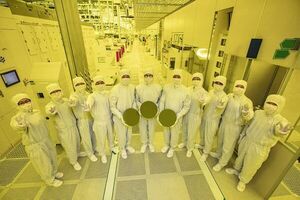
Samsung Begins Chip Production Using 3nm Process Technology With GAA Architecture
"Optimized 3nm process achieves 45% reduced power usage, 23% improved performance and 16% smaller surface area compared to 5nm process. Samsung Electronics, the world leader in semiconductor technology, today announced that it has started initial production of its 3-nanometer (nm) process node applying Gate-All-Around (GAA) transistor architecture. Multi-Bridge-Channel FET (MBCFET™), Samsung’s GAA technology implemented for the first time ever, defies the performance limitations of FinFET, improving power efficiency by reducing the supply voltage level, while also enhancing performance by increasing drive current capability. Samsung is starting the first application of the nanosheet transistor with semiconductor chips for high performance, low power computing application and plans to expand to mobile processors. “Samsung has grown rapidly as we continue to demonstrate leadership in applying next-generation technologies to manufacturing, such as foundry industry’s first High-K Metal Gate, FinFET, as well as EUV. We seek to continue this leadership with the world’s first 3nm process with the MBCFET™,” said Dr. Siyoung Choi, President and Head of Foundry Business at Samsung Electronics." [...]

STMicroelectronics releases next-generation Bluetooth® system-on-chip, enhanced with latest positioning capabilities
"STMicroelectronics has introduced its third-generation Bluetooth® System-on-Chip (SoC), enhanced with Bluetooth direction finding technology for location-tracking and real-time positioning applications. By determining the direction of a Bluetooth Low Energy (BLE) signal, the Bluetooth 5.3 certified BlueNRG-LPS SoC can precisely estimate movement and location with centimetre accuracy. It uses Bluetooth-specified technology including both angle-of-arrival (AoA) and angle-of-departure (AoD), as computed from signals captured by an antenna array. With this capability, the SoC now enables a wide variety of applications that require indoor navigation, geofencing, and asset tracking, as well as real-time location finding for tools, assets, and goods. With its streamlined architecture and I/O peripherals, and program and data memories (192KB eFlash and 24KB SRAM, respectively) sized for lightweight end products, BlueNRG-LPS is ideal for cost-sensitive and high-volume applications. These include general-purpose wireless sensors, medical appliances, keyless-entry systems, remote controls, and smart remote metering." [...]

Renesas and Cyberon Partner to Deliver Integrated Voice User Interface Solutions for Renesas RA MCUs Supporting Over 40 Global Languages
"Customers to Quickly Add Voice Recognition Technology for Endpoint Applications Within Home Appliances, Building Automation, Industrial Automation and Many More. Renesas Electronics Corporation (TSE:6723), a premier supplier of advanced semiconductor solutions, and Cyberon Corporation, a leading embedded speech solution provider, today announced that they have partnered to deliver voice user interface (VUI) solutions for customers using Renesas’ entire RA MCU line. Renesas RA customers will now have complimentary access to Cyberon’s industry-leading continuous command-based VUI toolchain, enabling them to add voice-recognition to a variety of endpoint applications in home appliances, building automation, industrial automation, wearables, and many more. Voice recognition is growing rapidly worldwide, driven by the explosion of IoT applications and the COVID-19 pandemic. Cyberon’s proven voice-recognition technology has been adopted in millions of devices worldwide. Renesas is making a Voice Reference Hardware Platform available to enable rapid prototyping and development of voice interfaces." [...]
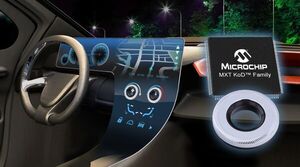
New maXTouch® Knob-on-Display™ (KoD™) Touch Controller Family Disrupts Traditional Touchscreen Designs
"Our maXTouch KoD controller enables innovative Human-Machine Interface (HMI) solutions by combining mechanical knobs with existing multi-touch displays. Many automotive and industrial touch HMI designers are looking to merge the benefits of a mechanical rotary encoder input with the flexibility of modern multi-touch displays. Microchip Technology Inc. (Nasdaq: MCHP) today announces the maXTouch® Knob-on-Display™ (KoD™) family of touchscreen controllers as the first automotive-grade touchscreen controller family to natively support the detection and reporting of capacitive rotary encoders, as well as mechanical switches on top of a touch panel. Unlike traditional mechanical rotary encoders, this new technology enables the mounting of the knob directly onto the display without an opening in the panel or any customization of the touch pattern, increasing design flexibility and system cost savings. The KoD technology eliminates the need for custom touch sensor patterns, providing designers the ability to easily implement a different knob count, shape and position to accommodate a variety of end-user products. The customized configurations are adjustable without changing the embedded firmware of the maXTouch KoD touch controller, leading to a faster and more flexible development cycle." [...]

Intel Labs Announces Integrated Photonics Research Advancement
"Intel Labs announces a significant advancement in its integrated photonics research – the next frontier in increasing communication bandwidth between compute silicon in data centers and across networks. The latest research features industry-leading advancements in multiwavelength integrated optics, including the demonstration of an eight-wavelength distributed feedback (DFB) laser array that is fully integrated on a silicon wafer and delivers excellent output power uniformity of +/- 0.25 decibel (dB) and wavelength spacing uniformity of ±6.5% that exceed industry specifications. What It Means: This advancement will enable the production of the optical source with the required performance for future high-volume applications, such as co-packaged optics and optical compute interconnect for emerging network-intensive workloads including artificial intelligence (AI) and machine learning (ML). The laser array is built on Intel’s 300-millimeter silicon photonics manufacturing process to pave the way for high-volume manufacturing and broad deployment. By 2025, Gartner forecasts that silicon photonics will be used in more than 20% of all high-bandwidth data center communications channels, up from less than 5% in 2020, and will represent a total available market of $2.6 billion. The growing demand for low power consumption, high bandwidth and faster data transfer is driving the need for silicon photonics to support data center applications and beyond." [...]

Three Wheeling: Startup Faction Develops Affordable Tri-Wheel AVs on NVIDIA DRIVE
"Some things are easy as A, B, C. But when it comes to autonomous vehicles, the key may be in one, two, three. Faction, a Bay Area-based startup and NVIDIA Inception member, is preparing to debut its business-to-business autonomous delivery service, with three-wheel production electric vehicles purpose-built for driverless operation, streamlining time to market. In addition, the company has built its autonomous driving system on NVIDIA DRIVE AGX for robust, automotive-grade AI compute. The demand for last-mile enterprise delivery has significantly increased over the past decade, with few signs of slowing down. The number of business-to-business parcels grew from 7 billion to 11 billion from 2019 to 2021, according to ABI Research. The firm expects this number to continue rising, to reach 75 billion in 2030." [...]

Touch controller from STMicroelectronics supports new-generation AMOLED energy-saving displays
"The FingerTip FTG2-SLP touchscreen controller from STMicroelectronics enables advanced features to support the latest active-matrix organic light-emitting diode (AMOLED) displays that promise more power saving and extended runtime in smartphones. Low-temperature polycrystalline oxide (LTPO) AMOLED displays, and similar proprietary equivalents, dynamically control the display refresh rate according to usage. While refreshing more slowly with the less demanding apps and reserving higher refresh rates for tasks like gaming and streaming, the display driver minimizes power consumption and assures great user experiences. ST’s FingerTip FTG2-SLP controller supports both synchronous and asynchronous display operations. This gives the OEMs the ability to maintain seamless user interactions as the refresh rate changes dynamically. The controller is also ideal for smartphones with flexible AMOLED displays that integrate the touch-sensitive panel directly on the OLED emitter layer for an extremely thin profile." [...]
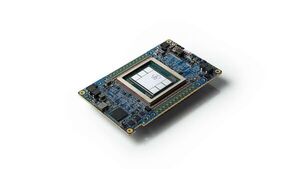
Second-Gen Habana Gaudi2 Outperforms Nvidia A100
"Intel today announced that its second-generation Habana® Gaudi®2 deep learning processors have outperformed Nvidia’s A100 submission for AI time-to-train on the MLPerf industry benchmark. The results highlight leading training times on vision (ResNet-50) and language (BERT) models with the Gaudi2 processor, which was unveiled in May at the Intel Vision event. Why It Matters: The Gaudi platform from Habana Labs, Intel’s data center team focused on deep learning processor technologies, enables data scientists and machine learning engineers to accelerate training and build new or migrate existing models with just a few lines of code to enjoy greater productivity, as well as lower operational costs. What It Shows: Gaudi2 delivers dramatic advancements in time-to-train (TTT) over first-generation Gaudi and enabled Habana’s May 2022 MLPerf submission to outperform Nvidia’s A100-80G for eight accelerators on vision and language models. For ResNet-50, Gaudi2 delivers a 36% reduction in time-to-train as compared to Nvidia’s TTT for A100-80GB and a 45% reduction compared to an A100-40GB 8-accelerator server submission by Dell for both ResNet-50 and BERT. Compared to first-generation Gaudi, Gaudi2 achieves a 3x speed-up in training throughput for ResNet-50 and 4.7x for BERT." [...]
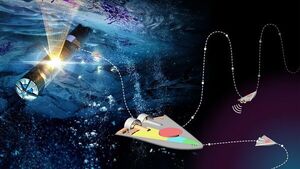
Swarm of Tiny Swimming Robots Could Look for Life on Distant Worlds
"A concept in development at NASA’s Jet Propulsion Laboratory would allow potential planetary missions to chase interesting clues in subsurface oceans. Someday, a swarm of cellphone-size robots could whisk through the water beneath the miles-thick icy shell of Jupiter’s moon Europa or Saturn’s moon Enceladus, looking for signs of alien life. Packed inside a narrow ice-melting probe that would tunnel through the frozen crust, the tiny robots would be released underwater, swimming far from their mothercraft to take the measure of a new world. That’s the vision of Ethan Schaler, a robotics mechanical engineer at NASA’s Jet Propulsion Laboratory in Southern California, whose Sensing With Independent Micro-Swimmers (SWIM) concept was recently awarded $600,000 in Phase II funding from the NASA Innovative Advanced Concepts (NIAC) program. The funding, which follows his 2021 award of $125,000 in Phase I NIAC funding to study feasibility and design options, will allow him and his team to make and test 3D-printed prototypes over the next two years. A key innovation is that Schaler’s mini-swimmers would be much smaller than other concepts for planetary ocean exploration robots, allowing many to be loaded compactly into an ice probe." [...]

My Favorite Martian Image: ‘Enchanted’ Rocks at Jezero Crater
"Not even Obi-Wan Kenobi could convince Perseverance’s Katie Stack Morgan that these are not the rocks she’s looking for. Ask any space explorer, and they’ll have a favorite photograph or two from their mission. For Katie Stack Morgan, the deputy project scientist for NASA’s Perseverance Mars rover, the first close-up image of layered rocks at the base of Jezero Crater’s ancient river delta holds a special place in her heart. The image of the “Enchanted Lake” rocky outcrop, informally named after a landmark in Alaska’s Katmai National Park and Preserve, was taken by one of the rover’s Hazard Avoidance Cameras (Hazcams) on April 30, 2022. A massive fan-shaped collection of rocks and sediment at the western edge of Jezero Crater, the delta formed at the convergence of a Martian river and a crater lake billions of years ago. Exploring this delta has been on Stack Morgan and the rest of the Perseverance science team’s wish list because they believe the location provides one of the mission’s best opportunities to find rocks that could have preserved remnants of ancient microbial life – a primary goal of the mission." [...]

Rocket Lab Successfully Launches CAPSTONE Spacecraft, Completes First Leg of Moon Mission for NASA
"Rocket Lab USA, Inc. (Nasdaq: RKLB) (“Rocket Lab” or “the Company”), a leading launch and space systems company, has successfully launched CAPSTONE, a microwave-oven-sized satellite designed to test a new orbit around the Moon for NASA. CAPSTONE was launched at 09:55 UTC, June 28 on an Electron rocket from Rocket Lab Launch Complex 1 in Mahia, New Zealand. The mission was Rocket Lab’s 27th Electron launch. Designed and built by Tyvak Nano-Satellite Systems, a Terran Orbital Corporation, and owned and operated by Advanced Space on behalf of NASA, the Cislunar Autonomous Positioning System Technology Operations and Navigation Experiment (CAPSTONE) CubeSat will be the first spacecraft to test the Near Rectilinear Halo Orbit (NRHO) around the Moon. This is the same orbit intended for NASA’s Gateway, a multipurpose Moon-orbiting station that will provide essential support for long-term astronaut lunar missions as part of the Artemis program. “Today’s launch was an important step in humanity’s return to the Moon and a testament to the determination, resolve, and innovation of the hundreds of people behind CAPSTONE,” said Rocket Lab founder and CEO, Peter Beck." [...]
Ciência e Tecnologia

Ancient microbes may help us find extraterrestrial life forms
"Using light-capturing proteins in living microbes, scientists have reconstructed what life was like for some of Earth’s earliest organisms. These efforts could help us recognize signs of life on other planets, whose atmospheres may more closely resemble our pre-oxygen planet. The earliest living things, including bacteria and single-celled organisms called archaea, inhabited a primarily oceanic planet without an ozone layer to protect them from the sun’s radiation. These microbes evolved rhodopsins — proteins with the ability to turn sunlight into energy, using them to power cellular processes. “On early Earth, energy may have been very scarce. Bacteria and archaea figured out how to use the plentiful energy from the sun without the complex biomolecules required for photosynthesis,” said UC Riverside astrobiologist Edward Schwieterman, who is co-author of a study describing the research." [...]
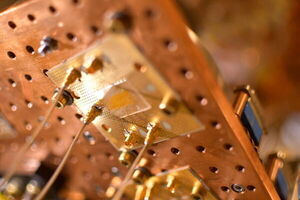
Tuning sound waves on chip
"Researchers control and modulate acoustic waves on chip for the first time. Acoustic waves are slower than electromagnetic waves of the same frequency but, even in the high-speed world of computing and communications, that’s not a bad thing. Short acoustic waves are easy to confine in nanoscale structures, do not readily talk with each other and have strong interactions with the system in which they are confined, making them useful for both classical and quantum applications. Now, researchers from the Harvard John A. Paulson School of Engineering and Applied Sciences (SEAS) have demonstrated the control and modulation of acoustic waves with an electric field on chip for the first time. “Acoustic waves are promising as on-chip information carriers for both quantum and classical information processing but the development of acoustic integrated circuits has been hampered by the inability to control acoustic waves in a low-loss, scalable manner,” said Marko Loncar, Tiantsai Lin Professor of Electrical Engineering at SEAS and senior author on this work. “In this work, we showed we can control acoustic waves on an integrated lithium niobate platform, bringing us one step closer to an acoustic integrated circuit.” The research was published in Nature Electronics." [...]

A rethink of the building blocks for solar panels could help mass production
"An original approach to mass-producing low-cost solar cell foundation blocks could lead to the wide adoption of solar panels made from perovskite ink – a "miracle material" – according to research from the University of Surrey. In the paper published in Scientific Reports, Dr Ehsan Rezaee, a post-doctoral fellow of the Advanced Technology Institute (ATI) at the University of Surrey, explains his research: "The objective is simply to produce solar cell building blocks out of perovskite ink. Whilst perovskite ink is not a new technology, current inks do not guarantee seamless transitions on an industrial scale, as the manufacturing process needs to be highly controlled and optimised. "Our perovskite ink produces a fast and reproducible way to reliably fabricate these solar cell building blocks on a mass scale, paving the way for its use in commercial markets." Perovskite solar cells are a low-cost, lightweight solution and can be built either rigid or flexible, with more possibilities to easily transport and install. The new study examines the foundation blocks of solar cells made of perovskite rather than the traditional silicon, as perovskite cells harvest light through the visible part of the solar spectrum, which has more energy." [...]

Building explainability into the components of machine-learning models
"Researchers develop tools to help data scientists make the features used in machine-learning models more understandable for end users. Explanation methods that help users understand and trust machine-learning models often describe how much certain features used in the model contribute to its prediction. For example, if a model predicts a patient’s risk of developing cardiac disease, a physician might want to know how strongly the patient’s heart rate data influences that prediction. But if those features are so complex or convoluted that the user can’t understand them, does the explanation method do any good? MIT researchers are striving to improve the interpretability of features so decision makers will be more comfortable using the outputs of machine-learning models. Drawing on years of field work, they developed a taxonomy to help developers craft features that will be easier for their target audience to understand." [...]

The 4D-printed beetle that changes color when it gets wetter
"How iridescent animals are leading the way to smart sensors. 3D printing has become mainstream. For a few hundred euros you can buy a 3D printer online. But what about 4D printing? How do you print an object that can change over time, for example by reacting to touch, light or moisture? It turns out that this is not as easy as you might think." [...]
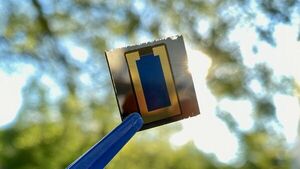
Thin-film Photovoltaic Technology Combines Efficiency and Versatility
"Researchers at KIT develop perovskite/CIS tandem solar cells with an efficiency of nearly 25 percent; combination of materials enables mobile applications. Stacking solar cells increases their efficiency. Working with partners in the EU-funded PERCISTAND project, researchers at the Karlsruhe Institute of Technology (KIT) have produced perovskite/CIS tandem solar cells with an efficiency of nearly 25 percent – the highest value achieved thus far with this technology. Moreover, this combination of materials is light and versatile, making it possible to envision the use of these tandem solar cells in vehicles, portable equipment, and devices that can be folded or rolled up. The researchers present their results in the journal ACS Energy Letters (DOI: 10.1021/acsenergylett.2c00707) Perovskite solar cells have made astounding progress over the past decade. Their efficiency is now comparable to that of the long-established silicon solar cells." [...]
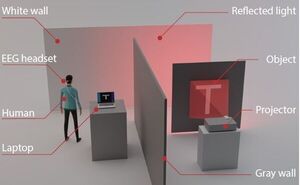
Researchers Perform Non-line-of-sight Ghost Imaging with Human Vision
"Researchers have shown that the computational imaging technique known as ghost imaging can be combined with human vision to image an object that can’t directly be seen by the person. The new work represents a step toward combining human intelligence with artificial intelligence. “We believe that this work provides ideas that one day might be used to bring together human and artificial intelligence,” explained Daniele Faccio, Professor of Quantum Technologies, School of Physics and Astronomy, University of Glasgow. “The next steps in this work range from extending the capability to provide 3D depth information to looking for ways to combine multiple information from multiple viewers at the same time.” Daniele Faccio from the University of Glasgow in the UK will present the new findings at the Optica (formerly OSA) Imaging and Applied Optics Congress 11 – 15 July 2022. Entitled “Non-Line-of-Sight (NLoS) Imaging and Imaging through Scattering Media,” Faccio will present on Monday, 11 July at 15:00 PDT. Ghost imaging forms an image of an object by correlating a projected light pattern that interacts with the object and a reference pattern that does not." [...]

New capability supports advanced laser additive manufacturing
"ANSTO’s capabilities to support additive manufacturing have been greatly strengthened with the installation of the first-in-the-world custom-built powder Laser Metal Deposition (LMD) system that can be used for in-situ* experiments at the Australia Centre for Neutron Scattering. The project was co-funded by a Research Attraction and Acceleration grant from the Office of the Chief Scientist and Engineer (NSW), the National Collaborative Research Infrastructure Strategy (NCRIS) and ANSTO. After eighteen months of design work and manufacturing, the system has been commissioned on the Kowari strain scanner. The new LMD system enables researchers to undertake neutron measurements during powder-fed laser additive manufacturing and is expected to provide real-time information about the deposition process to enable further optimisation. Although some refinements are needed to facilitate ease of operation and potential use on the other neutron instruments, Prof Anna Paradowska, Industry Engagement Manager Australian Centre for Neutron Scattering and Conjoint Professor at The University of Sydney, said the development of the sample environment system is a considerable technical achievement that was designed and constructed by ANSTO. “We have a great technical and design team that pushed the boundaries of what could be achieved for this important area of research." [...]

Advanced Technology Allows Automated 3D Tracking of Leaked Gas
"Researchers have developed a way to create a 3D image of a leaked gas cloud that provides detailed information about the leak such as location, volume and concentration. The new automated detection approach could be used to provide early warnings, assess risk or determine the best way to fix the leak. “With the rapid development of society, there are now large facilities located around the world where toxic, harmful, flammable and explosive chemicals are being stored,” said the research team leader Liang Xu from the Anhui Institute of Optics and Fine Mechanics, Chinese Academy of Sciences. “If there is a leak at one of these facilities, it’s important to quickly understand its composition, concentration, location and distribution.” The researchers describe their new method in the Optica Publishing Group journal Optics Express. It combines information from two remote Fourier-transform infrared spectroscopy (FTIR) imaging systems with precise positioning information from GPS and gyroscope sensors to create a 3D image of the gas cloud superimposed on a Google Earth digital map. “Previously, when leaks occurred, the specific location and direction the gas was moving could not be determined,” said Yunyou Hu, first author of the paper." [...]
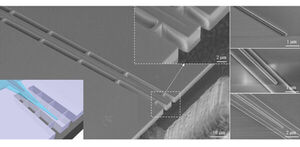
Ultrabroadband edge coupler for highly efficient second harmonic generation
"Thin-film lithium niobate edge coupler enables on-chip second harmonic generation. Thin-film lithium niobate (TFLN) has recently emerged as a versatile nanophotonic platform. With the advantages of high optical confinement, enhanced light–matter interaction, and flexible dispersion control, TFLN-based periodically poled lithium niobite (PPLN) devices outperform their legacy counterparts in both nonlinear optical efficiency and device footprint. A major challenge of TFLN-based PPLN devices is how to achieve efficient and broadband off-chip coupling. Due to the lack of an efficient broadband coupling scheme, the overall and on-chip second-harmonic generation (SGH) normalized efficiencies (fiber-to-fiber) are too low for many practical applications of TFLN-based PPLN devices. To date, it is possible to achieve high coupling efficiency at the C-band, but an efficient edge coupler that can cover both near-infrared (~1550 nm) and near-visible (~775 nm) wavelengths has not been developed until now." [...]

Quantum network nodes with warm atoms
"Communication networks need nodes at which information is processed or rerouted. Physicists at the University of Basel have now developed a network node for quantum communication networks that can store single photons in a vapor cell and pass them on later. In quantum communication networks, information is transmitted by single particles of light (photons). At the nodes of such a network buffer elements are needed which can temporarily store, and later re-emit, the quantum information contained in the photons. Researchers at the University of Basel in the group of Prof. Philipp Treutlein have now developed a quantum memory that is based on an atomic gas inside a glass cell. The atoms do not have to be specially cooled, which makes the memory easy to produce and versatile, even for satellite applications." [...]
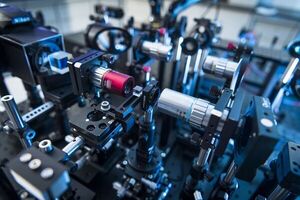
CityU’s Novel metalens revolutionises conventional Vacuum UV optics technology
"A research team co-led by City University of Hong Kong (CityU) have successfully developed a novel Vacuum Ultra-Violet (VUV) meta-lens which can generate and focus the VUV light, a disruptive technology for the UV optics market. VUV is used in semiconductor manufacturing, photochemistry and materials science. The focused VUV light source is strongly needed for nanolithography, material processing, advanced manufacturing, and other industrial areas. However, it has been costly to work with. VUV with wavelengths between 100 to 200 nanometres (nm), is strongly absorbed by the oxygen in air, and VUV’s application requires a vacuum chamber or other specialised environment. Conventionally, very bulky and expensive systems with special and rare nonlinear crystals are used for generating and focusing of VUV light." [...]
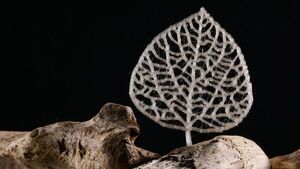
New PET-like plastic made directly from waste biomass
"EPFL scientists have developed a new, PET-like plastic that is easily made from the non-edible parts of plants. The plastic is tough, heat-resistant, and a good barrier to gases like oxygen, making it a promising candidate for food packaging. Due to its structure, the new plastic can also be chemically recycled and degrade back to harmless sugars in the environment. It is becoming increasingly obvious that moving away from fossil fuels and avoiding the accumulation of plastics in the environment are key to addressing the challenge of climate change. In that vein, there are considerable efforts to develop degradable or recyclable polymers made from non-edible plant material referred to as “lignocellulosic biomass”. Of course, producing competitive biomass-based plastics is not straightforward." [...]

Flexing the Power of a Conductive Polymer
"A new material holds promise for the next generation of organic electronics. For decades, field-effect transistors enabled by silicon-based semiconductors have powered the electronics revolution. But in recent years, manufacturers have come up against hard physical limits to further size reductions and efficiency gains of silicon chips. That has scientists and engineers looking for alternatives to conventional metal-oxide semiconductor (CMOS) transistors. “Organic semiconductors offer several distinct advantages over conventional silicon-based semiconducting devices: they are made from abundantly available elements, such as carbon, hydrogen and nitrogen; they offer mechanical flexibility and low cost of manufacture; and they can be fabricated easily at scale,” notes UC Santa Barbara engineering professor Yon Visell, part of a group of researchers working with the new materials. “Perhaps more importantly, the polymers themselves can be crafted using a wide variety of chemistry methods to endow the resulting semiconducting devices with interesting optical and electrical properties." [...]

UH Research Allows For 3-D Printing Of 'Organic Electronics'
"When looking at the future of production of micro-scale organic electronics, Mohammad Reza Abidian – Associate Professor of Biomedical Engineering at the Cullen College of Engineering – sees their potential for use in flexible electronics and bioelectronics, via multiphoton 3-D printers. The newest paper from his research group examines the possibility of that technology. “Multiphoton Lithography of Organic Semiconductor Devices for 3D Printing of Flexible Electronic Circuits, Biosensors, and Bioelectronics” was published online June 16 in Advanced Materials, which has an impact factor of 30.85 as of 2020. Over the past few years, 3D printing of electronics have become a promising technology due to their potential applications in emerging fields such as nanoelectronics and nanophotonics. Among 3D microfabrication technologies, multiphoton lithography (MPL) is considered the state-of-the-art amongst the microfabrication methods with true 3D fabrication capability, excellent level of spatial and temporal control, and the versatility of photosensitive materials mostly composed of acrylate-based polymers/monomers or epoxy-based photoresists. “In this paper we introduced a new photosensitive resin doped with an organic semiconductor material (OS) to fabricate highly conductive 3D microstructures with high-quality structural features via MPL process,” Abidian said." [...]
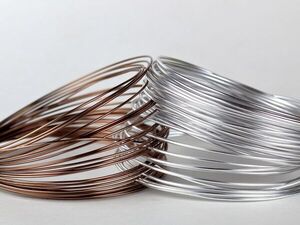
Cooking Up a Conductive Alternative to Copper with Aluminum
"First-ever simulation of aluminum conductivity offers a recipe for an inexpensive substitute for copper. In the world of electricity, copper is king—for now. That could change with new research from Pacific Northwest National Laboratory (PNNL) that is serving up a recipe to increase the conductivity of aluminum, making it economically competitive with copper. This research opens the door to experiments that, if fully realized, could lead to an ultra-conductive aluminum alternative to copper that would be useful in markets beyond transmission lines, revolutionizing vehicles, electronics, and the power grid. “What if you could make aluminum more conductive—even 80% or 90% as conductive as copper? You could replace copper and that would make a massive difference because more conductive aluminum is lighter, cheaper, and more abundant,” said Keerti Kappagantula, PNNL materials scientist and co-author on the research." [...]
New single-mode semiconductor laser delivers power with scalability
"Berkeley engineers have created a new type of semiconductor laser that accomplishes an elusive goal in the field of optics: the ability to emit a single mode of light while maintaining the ability to scale up in size and power. It is an achievement that means size does not have to come at the expense of coherence, enabling lasers to be more powerful and to cover longer distances for many applications. A research team led by Boubacar Kanté, Chenming Hu Associate Professor in UC Berkeley’s Department of Electrical Engineering and Computer Sciences (EECS) and faculty scientist at the Materials Sciences Division of the Lawrence Berkeley National Laboratory (Berkeley Lab), showed that a semiconductor membrane perforated with evenly spaced and same-sized holes functioned as a perfect, scalable laser cavity. They demonstrated that the laser emits a consistent, single wavelength, regardless of the size of the cavity. The researchers described their invention, dubbed Berkeley Surface Emitting Lasers (BerkSELs), in a study published today (Wednesday, June 29) in the journal Nature. “Increasing both size and power of a single-mode laser has been a challenge in optics since the first laser was built in 1960,” said Kanté." [...]
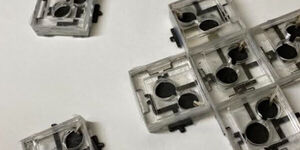
New biobatteries use bacterial interactions to generate power for weeks
"As our tech needs grow and the Internet of Things increasingly connects our devices and sensors together, figuring out how to provide power in remote locations has become an expanding field of research. Professor Seokheun “Sean” Choi — a faculty member in the Department of Electrical and Computer Engineering at Binghamton University’s Thomas J. Watson College of Engineering and Applied Science — has been working for years on biobatteries, which generate electricity through bacterial interaction. One problem he encountered: The batteries had a lifespan limited to a few hours. That could be useful in some scenarios but not for any kind of long-term monitoring in remote locations. In a new study, published in the Journal of Power Sources and supported by a $510,000 grant from the Office of Naval Research, Choi and his collaborators have developed a “plug-and-play” biobattery that lasts for weeks at a time and can be stacked to improve output voltage and current. Co-authors on the research are from Choi’s Bioelectronics and Microsystems Lab: current PhD student Anwar Elhadad, and Lin Liu, PhD ’20 (now an assistant professor at Seattle Pacific University)." [...]
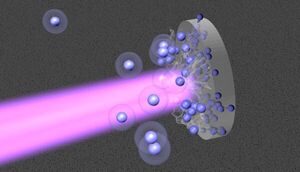
Breaking the strongest chemical bonds with laser shock compression
"Lawrence Livermore National Laboratory (LLNL) scientists recently obtained high-precision thermodynamic data on warm dense nitrogen at extreme conditions that could lead to a better understanding of the interiors of celestial objects like white dwarfs and exoplanets. The team, which includes researchers from the University of California, Berkeley and the University of Rochester, used an advanced technique that combines pre-compression in a diamond anvil cell and laser-driven shock compression at the Omega Laser Facility at the University of Rochester. Molecules of nitrogen (N2) make up 78% of the air we breathe.They are unique because the two nitrogen atoms in N2 are bound with a triple covalent bond, which is the strongest of all simple diatomic molecules. Nitrogen also is an important constituent of celestial bodies in the outer solar system and beyond. For example, ammonia (NH3) storms are believed to exist in giant planets like Jupiter, while the dwarf planet Pluto, Saturn’s icy moon Titan and Neptune’s icy moon Triton have N2-rich atmospheres. Previous studies with this powerful technique revealed experimental evidence for superionic water ice and helium rain in gas-giant planets." [...]

Pioneering recycling turns mixed waste into premium plastics with no climate impact
"Only a fraction of the material that could be turned into new plastic is currently recycled. Researchers at Chalmers have now demonstrated how the carbon atoms in mixed waste can replace all fossil raw materials in the production of new plastic. The recycling method is inspired by the natural carbon cycle and could eliminate the climate impact of plastic materials, or even clean the air of carbon dioxide. “There are enough carbon atoms in waste to meet the needs of all global plastic production. Using these atoms, we can decouple new plastic products from the supply of virgin fossil raw materials. If the process is powered by renewable energy, we also get plastic products with more than 95% lower climate impact than those produced today, which effectively means negative emissions for the entire system,” says Henrik Thunman, Professor of Energy Technology at Chalmers University of Technology and one of the authors of the study published in the Journal of Cleaner Production." [...]
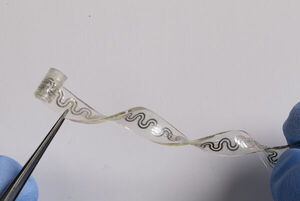
Dissolving implantable device relieves pain without drugs
"A Northwestern University-led team of researchers has developed a small, soft, flexible implant that relieves pain on demand and without the use of drugs. The first-of-its-kind device could provide a much-needed alternative to opioids and other highly addictive medications. The biocompatible, water-soluble device works by softly wrapping around nerves to deliver precise, targeted cooling, which numbs nerves and blocks pain signals to the brain. An external pump enables the user to remotely activate the device and then increase or decrease its intensity. After the device is no longer needed, it naturally absorbs into the body — bypassing the need for surgical extraction. The researchers believe the device will be most valuable for patients who undergo routine surgeries or even amputations that commonly require post-operative medications." [...]
Documentação
A documentação é parte essencial do processo de aprendizagem e a Internet além de artigos interessantes de explorar também tem alguma documentação em formato PDF interessante de ler. Todos os links aqui apresentados são para conteúdo disponibilizado livremente pelo editor do livro.

The MagPi 119
"Inside The MagPi magazine #119 - Raspberry Pi Pico W. In-depth guide to Raspberry Pi’s new RP2040 microcontroller-based development board with engineering interviews. - Bringing KITT back to life. How one maker is using voice recordings and LED displays to bring the inspirational AI assistant from Knight Rider to life. - Build an abstract art installation. Use Raspberry Pi to create abstract images and display them on an LCD screen. - Reuse your Raspberry Pi." [...]
Projetos Maker
Diversos Projetos interessantes.
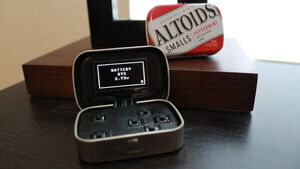
mintyPico
"USAGE: The top left button starts games The bottom left button switches the pico into "low-power" mode (disables display and turns cpu clock frequency down 5x) To switch the Pico back into normal mode, while holding the low-power button, press the right button, then the top button, then the left button The four rightmost buttons operate the games" [...]
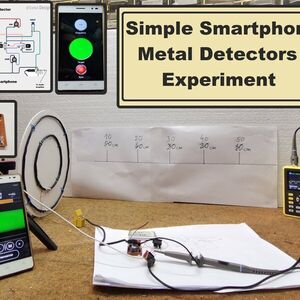
Simple Smartphone Metal Detector Experiments
"I will try to describe the principle of operation of a simple Metal detectors in which data is processed by a smartphone. The main principle of this detectors consists of LC oscillator which serves as a reference, and on the other side a smartphone application, which is basically a frequency meter. When we put a metal object near to the coil the frequency changes and application detect the change and signalize that there is are metal object near the coil. The oscillator consists of a parallel LC oscillator circuit and two transistors. The frequency of this oscillator depends on the inductance of the coil and the capacitance of the capacitor. I also put two trimmer potentiometers instead of resistors so we can change the amplitude and partial shape of the signal to make it easier to process in the smartphone app." [...]
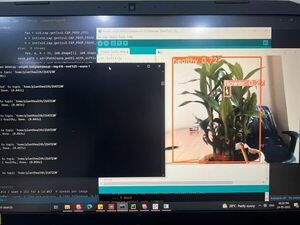
Smart Plant Irrigation with Health Detection
"It can detect the moisture level and shows the current humidity level and temperature in degrees, as well as the plant's health condition. How to Use Oled Display, Capacitive Moisture Sensor, DHT11 Temperature, Humidity Sensor and Relays with WIZnet Pico In this project, we'll create a smart irrigation system that can detect the moisture level in the water and irrigate the plant accordingly. The system also contains a failsafe mechanism that allows the moisture sensor to recalibrate so that the plant is not overwatered. It also shows the current humidity level and temperature in degrees, as well as the plant's health condition, which is presented on the OLED screen. This project employs YOLOV5, a powerful object detection model capable of monitoring plant health in real time and transmitting the information to a MQTT server. The MQTT server sends messages to the Raspberry PICO, which it displays on the OLED panel." [...]
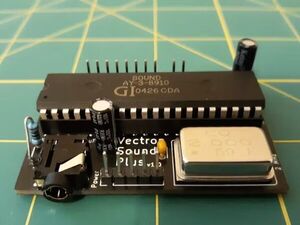
Vectron Sound Plus
"Chiptunes, anyone? Vectron Sound Plus uses the General Instrument AY-3-8910 sound generator to produce 8-bit retro audio. The simple design exposes the AY-3-8910's data bus and control pins so that an external system can control it. The required crystal oscillator and audio output circuitry are also included so that any speaker can be connected via a TRS cable through the onboard jack. Bill of Materials - 1 x General Instrument AY-3-8910 sound generator - 1 x 2 MHz crystal oscillator - 1 x 220 uF electrolytic capacitor - 1 x 47 uF electrolytic capacitor - 1 x 1K resistor - 2 x 0.1 uF ceramic capacitors - 1 x TRS jack connector - 1 x PCB (Kicad design files)" [...]
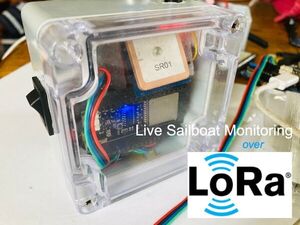
Live Sailboat Monitoring Over LoRa
"This project is for building a live sailboat tracking system that communicates over LoRa with E22-900M30S modules! Supplies - 3x DFRobot FireBeetle ESP32 IOT Microcontroller (Supports Wi-Fi & Bluetooth) - 2x DFRobot GPS Module with Enclosure - 2x DFRobot Gravity: I2C BMI160 6-Axis Inertial Motion Sensor - 3x E22-900M30S Ebyte radio module. I bought mine from Ebay, although Amazon, Ebyte, and LCSC carry them also. - 3x 915Mhz LoRa Antenna. I bought 2dBi ones, although 4-5dBi is optimal. - 3x Capacitor 47 µF; Filtering capacitors for the radio modules." [...]
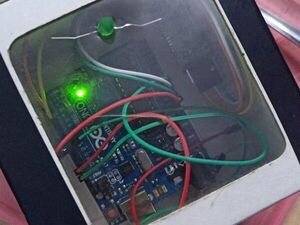
Yoga Pose Detector
"Hi friends, how are you :-) hope you all are doing well, I have made a Yoga Pose Detector using machine learning integrated with Arduino. Hello everyone, we have created this AI based project named as the "YOGA POSE DETECTOR". In creating this project, we have used a technique of deep learning known as TRANSFER LEARNING. After creating data set and fine tuning the model, we deployed it over google cloud platform and After successfully deploying this model, we used Arduino Uno , which is a microcontroller, to fetch the detection from the AI model based on cloud and display it on an android app, that we developed, through Bluetooth. Hence, this is how, we have prepared this project through which we can detect the yoga pose performed in front of your camera. let's start making project with collection of data set all you need to do is to click some photos and upload it on teachable machine platform." [...]

Cyber Tail
"About 25 million years ago, our ancestors lost their tails during the evolution to better adapt to the the environment. Today, as we live in the digital age, our bodies are evolving along with the cyber world. What would a cybernetic tail bring to our daily life? With the easily accessible technologies, such as Arduino and 3D printing, you can make your own cyber tail! Supplies: - Arduino Uno - Infrared reflective sensor module TRCT5000 - Accelerometer MPU6050 - Servo motor SG90 (x4) - Capacitor (x4) - 9v battery - EPE foam rods" [...]
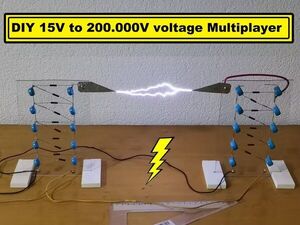
DIY 15V to 200.000 V Cockroft-Walton voltage multiplier
"The Cockcroft–Walton generator, or multiplier, is an electric circuit that generates a high DC voltage from a low-voltage AC or pulsing DC. The Cockcroft–Walton generator, or multiplier, is an electric circuit that generates a high DC voltage from a low-voltage AC or pulsing DC input. Multipliers are typically used to develop higher voltages for relatively low-current applications such as laser systems, X-ray systems, air ionisers, cathode ray tubes etc... The circuit consists of cascading high-voltage capacitors and diodes, so theoretically each subsequent cascade of two capacitors and two diodes should double the input voltage. In one of my previous videos (https://www.youtube.com/watch?v=EFtNDtW804Q) you can see this type of multiplayer made with ten cascades where the output have a voltage of about 100 Kilovolts. To increase the output voltage, in this case I first tried to double the number of cascades but unfortunately the result was almost disappointing." [...]

Attiny13A Motor Controller Board
"Hey Guys how you doing! So here's something super interesting and useful, a motor controller board powered by an Attiny13A to control a Brushed DC Motor. This Motor Driver uses PWM to control the gate of an N Channel IRFZ44N mosfet by the Tap of a single button. I've added Two Modes in the code that basically controls the Duty Cycle, On First Tap the setup turns ON at 100% Duty cycle, then on the Second Tap, the Duty Cycle is half at 50%. The third Tap turns the whole setup OFF. I made this Motor Controller board for a future project that is a Bladeless Fan Project that I will soon publish." [...]

Cosplay PSU
"A pocket, rechargeable battery PSU for powering small Cosplay-related projects (and not only) I build the Wearable Arc Reactor by Misha Tikh some times ago (it's the one appears in this project cover picture) and I wanted a reliable power supply for powering it. So this thing come in my mind: a small box having a 18650 Li-Ion cell with a booster module giving the 9V for powering leds and a recharging module with accessible USB. Warnings There are some premises to say before starting to do a similar project: - Li-Ion and Li-Po battery can be very dangerous if not properly handled, so I cannot take any responsibility for damages caused by this project. - The Recharging module used here has NO protection: I choosed this for compactness purposes and because I had lot of them from some years ago, but is not the safest. Anyway I designed the enclosure around this specifical module. - Would be better put this object in an explosive/fire-proof bag, expecially if used for cosplay purposes since it can be in contact with your body." [...]

Arduino SELF-BALANCING Robot
"Today in this tutorial, I have made a SELF-BALANCING robot with ARDUINO. I hope this article will help the beginners to make it properly. For the mechanical Part, we will need - PVC SHEET - GRAPHITE PENCILS - GEAR MOTOR - MOTOR BRACKET - WHEELS For The Electronics Part, we will need - Arduino Nano - L298n motor driver - MPU6050 module - 18650 Li-ion Battery - 18650 Li-ion battery Holder - Rocker Switch" [...]
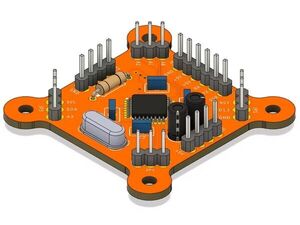
ATMEGA328P Low Cost Development Board for Prototypes
"You'll access the file and learn how to use this board to create all type of prototypes and product tests. In recent years I have developed numerous prototypes with Arduino. During these creations, something always bothered me. Using an Arduino board in a prototype took up a lot of space, was expensive, and made it difficult to connect wires. Some prototypes became too big because I was using an Arduino with shields. You and many others will experience this problem and will likely struggle to create new product solutions and prototypes." [...]
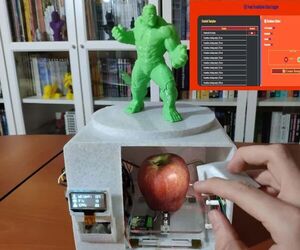
IoT AI-driven Food Irradiation Dose Detector W/ Edge Impulse
"Collate weight, color, and emitted ionizing radiation of foods to train a NN. Then, run it on Beetle C3 to detect food irradiation doses. Supplies 1 x DFRobot Beetle ESP32 - C3 1 x Raspberry Pi 3B+ or 4 1 x DFRobot Gravity: Geiger Counter Module 1 x DFRobot Gravity: I2C 1Kg Weight Sensor 1 x DFRobot Fermion: 1.51” OLED Transparent Display 1 x DFRobot Gravity: AS7341 11-Channel Visible Light Sensor 1 x Creality CR-200B 3D Printer 3 x Button (6x6) 1 x Xiaomi 20000 mAh 3 Pro Type-C Power Bank 1 x USB Buck-Boost Converter Board 1 x Breadboard 1 x Mini Breadboard 1 x Jumper Wires Even though food irradiation improves food hygiene, spoilage reduction, and extension of shelf-life, it should be regulated strictly to avoid any health risks and nutritional value drops. However, small businesses in the food industry lack a budget-friendly and simple way to detect food irradiation doses after treating food with ionizing energy, especially for animal (livestock) feed. Therefore, I decided to build an AI-driven IoT device predicting food irradiation doses based on weight, color (visible light), and emitted ionizing radiation. Ionizing radiation is a nonthermal process utilized to achieve the preservation of food." [...]

Trouble Maker
"A Truth or Dare generator based on Markov Chain Trouble Maker is a game-gadget that generates random prompts for Truth or Dare using Markov Chain. Truth or Dare is a classic party game, which places the player in a dilemma between answering a personal question or performing a challenging task. However, running out of prompts is a common pain point of the game. It is challenging to continuously devise clever prompts yourself and the prompts you can find online are often limited and repetitive in content. We propose an innovative way to generate prompts using Markovify — a simple machine learning generator based on Markov Chain. Markovify predicts the next word based upon its previous word, but not the whole sentence." [...]
Crius ROT8 MIDI Controller
"Hi!I am Crius and I LOVE MIDI Controllers! The last couple of years I started learning about electronics from nothing to be able to build my own MIDI controllers that would serve my needs , taste and be cheaper overall in comparison with the branded products.This is CRIUS ROT8 MIDI CONTROLLER that consists of 8 potentiometers and 3 buttons with which we can control the parameters of the VST-Plugin or the DAW that we play music ,8 LEDs whose brightness varies depending on the position of the corresponding potentiometer as well as an LCD screen that shows the percentage of 100 for each potentiometer so that we can know at a glance the value of the parameter we have assigned it. The Crius ROT8 comes with a Script which allows us to automatically match (Auto Mapping) each of the 8 penometers with the corresponding Volume of 8 Tracks and the 3 buttons with PLAY, STOP and REC respectively, selecting Crius Rot8 as Control Surface from Menu Options -> Preferences -> Midi -> Control Surface (details for installing Script can be found below). If we do not use the Script we can do Mapping with anything we want in the DAW. HARDWARE COMPONENTS : 1. Crius Rot8 PCB x1 2." [...]

3D Unity game using MPU6050 and TinyML Tutorial
"Ever wanted to build your own Unity game, use an accelerometer for the controller or sprinkle a bit of AI in it? Well, here's how! I have always been fascinated by Wii controllers and I wanted to build a project based on a controller's IMU motion. So when I got selected to participate in the Google Summer of Code (GSoC) under TensorFlow, I proposed building a Unity game that could be controlled using a microcontroller. Here's how you could also build one. Happy Tinkering!" [...]
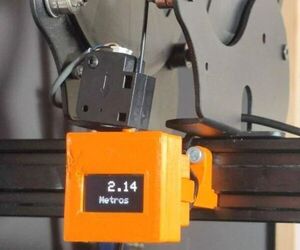
Mini Filament Counter for 3d Printer
"A couple of months ago I got a new roll of pla, I was printing things for a few days without any worries. Last week I went to print a large piece, 200 meters of filament according to Cura... I assumed there would be enough but no... So I decided that it was the last time that happened to me and I thought that if I counted the meters used , I could know the meters that were left. So I got to work and here it is, my mini filament counter! To say that it is not a regressive counter, that is, it does not mark what you have and subtract it and does not keep the memory, you must write down what you are spending on each roll and thus be able to keep track." [...]

Arduino Combination Safe
"Rotate the potentiometers in the correct sequence to access system! Ever watched the movie 'Army of Thieves' on Netflix? This project was inspired by how the character in the movie open the vaults, and how intricate the combination locks on the vaults were. I created it having three different sets of combination sequence. If User input the correct first combination then access granted, else it will move on to the next stored combination sequence for the user to try again. And if that is correct access granted, else it will move on to the last stored combination sequence for the user to try one final time." [...]
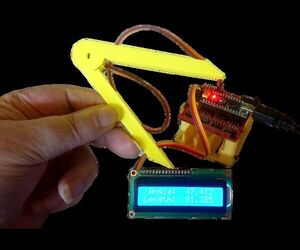
Tim's Electronic Dividers - 1D
"I thought I would do a small tool. A Pair of Electronic Dividers, to show the basic principles of a Hall-Effect Sensor. I did a little video just to show there use, while I was making the video I thought I would show how I find the poles of the magnets used. I will be using my 3D Printer to print the parts needed. Other materials can be used, but accuracy is a key factor in the assembly. I will be using a 49E Sensor with two magnets." [...]
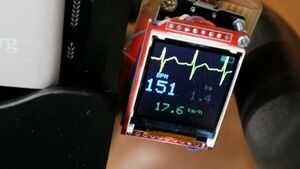
Orbitrack ESP32 computer with ECG
"ESP32 based computer for orbitrack that displays ECG shape and BPM charts, allowing to train at optimal load At the end of 2021 I got an orbitrack - and immediately wasn't happy about its in-built computer: not only it has poor visibility and no colors - but also its heart rate monitor works only when you keep hands on the bike's handlebar, it has no contacts on vertical moving parts. So I replaced it (in fact, did that a couple of weeks before the war hit, so shooting a video took just a bit longer than I anticipated) Even though this way speed/distance/calories data look nicer than on stock computer, that's not the main improvement. What is really important is that current heart rate is shown - both as a number and as a chart of BPM change over last 30 seconds - and most importantly, heart rate zone is color-coded. In order to get that part done, I've used uECG device which our team created a couple of years ago. In fact any other BLE heart rate monitor can be used as well - they won't give that nice ECG data, but they still output BPM and that's what matters most in practical terms. Heart rate zone defines how hard you are training and in which mode your body works." [...]

IoT based Smart Parking System using Raspberry Pi
"Parking is becoming one of the most common issues, it may be a Mall or a Theater, before entering the parking check if theirs any space! Introduction One of the most common problems today is a saturation of parking spaces. Vehicles continue to outnumber existing parking spaces, thus clogging roads. Incidences of violence over occupancy, deformed cars due to a space crunch, and overcharging for parking are some problems that result. Most cities propose increasing parking spaces to combat the problem. Parks and vacant plots are used as potential parking spaces and multi-level facilities are being built, irrespective of the limited land space and resources." [...]
Secção Videos
Videos interessantes.
That's all Folks!



